
Anyone who travels on Indian roads at night knows the feeling: a sudden flash of harsh white light straight into the eyes, forcing you to slow down, turn away, or even stop. The widespread misuse of high-beam headlights by drivers and riders has quietly grown into one of the biggest yet least-discussed road-safety problems in the country. From busy city streets to poorly lit highways, bright glare from oncoming vehicles is making night travel more stressful, more tiring and, in many cases, more dangerous.
What high beam is meant for
High-beam headlights are designed for specific situations. They are meant to be used only on dark, empty stretches where visibility is low and no other vehicle is approaching. However, in India, many motorists keep their high beam on throughout the journey—whether they are in the middle of a bustling market road or following another vehicle closely. This habit has turned into a daily nuisance. More importantly, it puts everyone at risk.
Why the glare is dangerous
The reason high beams are harmful is simple: glare. Bright, undipped headlights can temporarily blind oncoming traffic or the vehicle ahead. For a few seconds, the driver or rider loses the ability to see the road clearly. Those seconds are enough for someone to miss a pedestrian, misjudge a curve, or fail to spot a pothole or speed breaker. For two-wheeler riders, the danger is even higher because their eyes are directly exposed to the beam without any windshield protection.
Goa and similar regions face greater risk
In places like Goa, where thousands of residents rely on scooters and bikes, this issue becomes especially serious. Many riders say the glare forces them to slow down or look away, increasing the risk of imbalance. Others complain that even new vehicles come with very powerful LED lamps that make matters worse. On narrow or unlit roads, this can lead to close calls and avoidable accidents.
Why motorists misuse high beam
There are several reasons for the widespread use of high-beam lights. One is simple ignorance—many motorists are not taught when to use high beam and when to switch to low beam. The basic of headlight etiquette rarely gets enough attention during driving-licence training. Another major reason is poor road lighting. When streets are dark or full of broken lamps, drivers feel they have no option but to use high beam. Some people even modify their vehicles with brighter bulbs, unaware that they are blinding others. And at times, it is just carelessness or the belief that a brighter light gives more control over the road.
What the law says
Indian law is clear. High beams must not be used when another vehicle is approaching. They must be dipped within a certain distance, especially in well-lit areas. Misuse of headlights is a traffic violation and can attract fines. But enforcement is weak. Most drivers who travel on high beam every night have never been stopped or penalised. As a result, the habit continues unchecked.
What can be done
The solution lies in a mix of awareness, enforcement and better infrastructure. Public campaigns reminding motorists to dip headlights could make a difference, especially if supported by transport authorities and local police. Adding simple signs on highways—Use dipper at night—has worked in some regions and could be strengthened further using digital boards. More importantly, driving schools and RTOs should give proper attention to headlight rules during training and tests.
Better lighting and stricter checks
Improving street lighting is also essential. When roads are well lit, the natural dependency on high beam reduces. Regular checks on modified headlights, especially overly bright LEDs, could also help. Two-wheeler riders, who suffer the most, have long demanded stricter action on misuse.
A small habit that can save lives
Everyone on the road deserves to travel safely at night without being blinded by someone else’s lights. The high-beam menace may seem like a small issue, but it affects millions every day. With basic discipline, awareness and enforcement, Indian roads can become far safer and easier to navigate after dark.